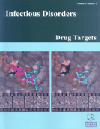- Home
- A-Z Publications
- Infectious Disorders - Drug Targets (Formerly Current Drug Targets - Infectious Disorders)
- Previous Issues
- Volume 6, Issue 3, 2006
Infectious Disorders - Drug Targets (Formerly Current Drug Targets - Infectious Disorders) - Volume 6, Issue 3, 2006
Volume 6, Issue 3, 2006
-
-
Editorial [Hot Topic: Differentially Regulated Genes to Understand Microbial Pathogenesis and for the Development of New Vaccine, Diagnostic and Antibiotherapy Strategies (Guest Editor: Dr. Martin Handfield)]
More LessMicrobiologists have realized that it is unlikely that all virulence determinants of a human pathogen could be identified simply by studying the pathogen in the laboratory since it is technically impossible to determine and mimic all of the complex and changing environmental stimuli that occur at the site of an infection. This shortcoming hampers our complete understanding of the virulence mechanisms employed by hum Read More
-
-
-
Development and Application of In Vivo Expression Technology (IVET) for Analysing Microbial Gene Expression in Complex Environments
More LessAuthors: R. W. Jackson and S. R. GiddensEstablishing the mechanisms by which microbes interact with their environment, including eukaryotic hosts, is a major challenge that is essential for the economic utilisation of microbes and their products. Techniques for determining global gene expression profiles of microbes, such as microarray analyses, are often hampered by methodological restraints, particularly the recovery of bacterial transcripts (RNA) from co Read More
-
-
-
High-Throughput Identification of Conditionally Essential Genes in Bacteria: From STM to TSM
More LessAuthors: J. T. Bosse, L. Zhou, J. S. Kroll and P. R. LangfordSignature-tagged mutagenesis (STM) provided the first widely applicable high-throughput method for detecting conditionally essential genes in bacteria by using negative selection to screen large pools of transposon (Tn) mutants. STM requires no prior knowledge of the bacterium's genome sequence, and has been used to study a large number of Gram-positive and Gram-negative species, greatly expanding the repertoires o Read More
-
-
-
DNA Microarrays - An Armory for Combating Infectious Diseases in the New Century
More LessBy T. ChenDNA microarrays are high-throughput platforms that take advantage of the vast amount of sequence information and allow scientists to perform gene expression profiling or genotyping studies on a “global” or “genomewide” scale. The global monitoring of gene expression in hosts and pathogens, either separately or interactively, has given us systemic views of the disease mechanisms. Ongoing improvements in DNA se Read More
-
-
-
Serial Analysis of Gene Expression in Eukaryotic Pathogens
More LessThe tag-based method of serial analysis of gene expression (SAGE) has been used to measure mRNA abundance and differential expression in a variety of organisms including several parasites and fungal pathogens. SAGE is based on the collection of short sequence tags as a measure of transcript abundance and the method provides an alternative, and in some instances, complementary approach to array-based method Read More
-
-
-
Microarray Analysis of Human Epithelial Cell Responses to Bacterial Interaction
More LessAuthors: Jeffrey J. Mans, Richard J. Lamont and Martin HandfieldHost-pathogen interactions are inherently complex and dynamic. The recent use of human microarrays has been invaluable to monitor the effects of various bacterial and viral pathogens upon host cell gene expression programs. This methodology has allowed the host response transcriptome of several cell lines to be studied on a global scale. To this point, the great majority of reports have focused on the response of immune Read More
-
-
-
Mass Spectrometry-Based Proteomics and its Application to Studies of Porphyromonas gingivalis Invasion and Pathogenicity
More LessAuthors: Richard J. Lamont, Marina Meila, Qiangwei Xia and Murray HackettPorphyromonas gingivalis is a Gram-negative anaerobe that populates the subgingival crevice of the mouth. It is known to undergo a transition from its commensal status in healthy individuals to a highly invasive intracellular pathogen in human patients suffering from periodontal disease, where it is often the dominant species of pathogenic bacteria. The application of mass spectrometry-based proteomics to the study of P. Read More
-
-
-
In Vivo Induced Antigen Technology (IVIAT) and Change Mediated Antigen Technology (CMAT)
More LessAuthors: Martin Handfield and Jeffrey D. HillmanIn this chapter, an overview of in vivo induced antigen technology (IVIAT) and change mediated antigen technology (CMAT) will be presented, including a discussion of the advantages and limitations of these methods. Over fifteen different microbial pathogens have been or are known to be currently studied with these methods. Salient data obtained from the application of IVIAT and/or CMAT to a selection of human and plant Read More
-
Volumes & issues
-
Volume 25 (2025)
-
Volume 24 (2024)
-
Volume 23 (2023)
-
Volume 22 (2022)
-
Volume 21 (2021)
-
Volume 20 (2020)
-
Volume 19 (2019)
-
Volume 18 (2018)
-
Volume 17 (2017)
-
Volume 16 (2016)
-
Volume 15 (2015)
-
Volume 14 (2014)
-
Volume 13 (2013)
-
Volume 12 (2012)
-
Volume 11 (2011)
-
Volume 10 (2010)
-
Volume 9 (2009)
-
Volume 8 (2008)
-
Volume 7 (2007)
-
Volume 6 (2006)
Most Read This Month
Article
content/journals/iddt
Journal
10
5
false
en


